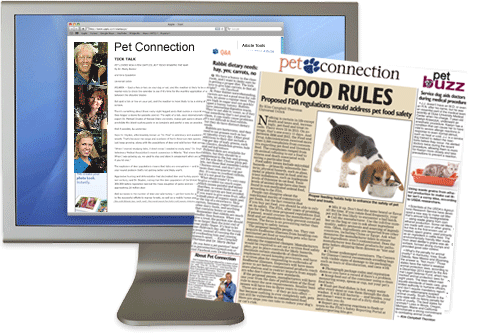Pet Connection
Available for print / Web / mobile
A breed apart! Pet Connection provides pet owners with the information they need and the stories they love. Award-winning journalist Kim Campbell Thornton knows the key questions facing pet owners and where to find the answers, as well as providing a wide range of human-interest stories about life with pets.
Description
Seek and Find
By Kim Campbell Thornton
You’ve probably seen beagles in airports, checking luggage for contraband foods and other items, or a German shorthaired pointer at a train station checking areas for explosives. A Labrador sniffs out electronic evidence in child predator cases. Search-and-rescue dogs seek survivors after disasters.
That’s because no electronic device has yet been created that beats out a dog’s nose. The number of olfactory receptor cells they have ranges from about 125 million for dachshunds to about 300 million for bloodhounds, compared to the measly 6 million or so doled out to humans.
Thanks to that powerful sense of smell, dogs are our partners in all kinds of detection. They sniff out prohibited fruits, vegetables and meats in airports; explosives, weapons and drugs; missing persons, alive or dead; and even termites infesting homes.
But dogs aren’t able to solve complex scent problems right out of the gate. They learn their job through a simple but highly effective technique: positive reinforcement.
“Training a detection dog is all fun,” says Chris Oliver, a full-time K9 handler for the sheriff’s department in Placer County, California, and owner of K9 Furst, where he trains professional and sport detection teams. “We don’t use fear. We don’t use force.”
Instead, handlers tap into a dog’s primal instinct — sniffing — and make it fun for them by pairing odors with rewards. Once the dog makes the association between odor and reward, he understands that odor yields reward, and his expectation and excitement for that reward increases, says Deresa Kenney, an instructor at the K9 Sport Scent Work Conference with more than 40 years’ experience in training service and search-and-rescue dogs.
When dogs discover that sniffing is fun and rewarding, they want to do it again and again. A narcotics or other detection dog will happily search for hours with the incentive of a few minutes of play with a tennis ball or tug toy. It’s not just the opportunity to play with the toy. Interaction with the handler is a reward, too.
Dogs learn to differentiate between and indicate the presence of specific scents by being rewarded for making correct decisions. Punishment isn’t part of the program. Too much pressure or intensity can cause the dog to stop working.
“It’s not fun to get hammered all the time,” Oliver says.
Positive training techniques encourage the dog to do exactly what the handler wants. The attention or rewards they receive when they make a find encourages them to repeat that successful behavior.
That’s not to say mistakes aren’t made, by either the dog or the handler. Inexperienced dogs may accidentally alert because of eagerness or confusion.
Handlers can accidentally cue dogs with body language — reaching for a toy too quickly, for instance — causing the dog to alert in the wrong area. Anything the handler does — talking or not talking, increasing or decreasing speed, leash handling — can influence the dog, says Christina Bunn of Puget Sound Detection Dogs, speaking in January at the K9 Sport Scent Work Conference in Palm Springs, California.
When that happens, physical or verbal correction isn’t the way to go. The stress that accompanies those actions makes it more difficult for a dog to learn, and can stifle his ability to blossom into a precise and accurate detection dog. Instead, a handler simply ignores the incorrect alert and lets the dog work out the puzzle by redirecting him.
“If you’re not making mistakes, you’re not learning,” Oliver says. “If you don’t fail, you don’t grow.”
And when it all goes right, it’s not only a successful search, but also a bonding experience.
Q&A
How often should
pets visit the vet?
Q: My 5-year-old cat is in good health and up-to-date on her vaccinations. She’s never had any health problems. Does she really need to see the veterinarian every year?
A: If your pet is healthy and in good condition, you may think it’s OK to skip annual veterinary exams, but a yearly look-see from your pet’s veterinarian is an essential part of keeping her healthy. Annual exams help ensure that disease doesn’t sneak up on you and adversely affect your cat’s health before you realize a problem has developed — and I can guarantee that your cat’s not going to tell you about it.
Annual examinations (or twice-yearly for senior pets) are the foundation of preventive care. They can prolong your cat’s life when your veterinarian discovers a problem early so that it can be treated before it becomes serious — and expensive!
You may even save money if you and your veterinarian team up to prevent health problems by ensuring that your cat (or dog) gets the right amount of food and exercise to prevent or reverse obesity, for instance.
I believe that young or adult pets need at least one wellness check annually, and seniors benefit from twice-yearly checkups. Because pets age at different rates (large dogs age most rapidly; cats and small dogs, more slowly), exactly when those twice-yearly exams begin depends on the individual animal.
I’ve been a veterinarian for close to four decades now, and I don’t know how many times I’ve had to give someone the worst news possible about a pet, knowing that if I’d had a chance to catch and treat a medical issue earlier, I could have saved the pet.
The bottom line? Don’t skip that yearly visit. You’ll be doing your cat — and your wallet — a big favor. — Dr. Marty Becker
Do you have a pet question? Send it to askpetconnection@gmail.com or visit Facebook.com/DrMartyBecker.
THE BUZZ
Mayor is real
“paw-litician”
— Georgetown, Colorado, has gone to the dogs — in a great way! The town’s newly elected honorary mayor is Parker the Snow Dog. Wearing a tie and glasses, the Bernese mountain dog, who is also the official mascot of Loveland Ski Area, was sworn in by police judge Lynette Kelsey. Parker campaigned on a platform that promised hugs, love and cookies to the people of Georgetown and was unanimously chosen by the town’s Board of Selectmen last month. When he’s not presiding at city hall, Parker is busy being furr-iendly with the Denver Broncos and Colorado Rockies, and visiting news personalities, as well as serving as a therapy dog at the Easterseals camp in Rocky Mountain Village.
— You’ve seen lost-pet flyers on telephone poles, but pizza boxes? Following in the pawprints of breweries that put pictures of missing pets on cans, John Sanfratello of Angelo’s Pizza in Matawan, New Jersey, decided to put lost-pet flyers on boxes of pizza being delivered after he saw a post about a lost cat on Facebook. Hazel the cat came home before her flyers went out, but Sanfratello is implementing the idea for other missing pets. He hopes other pizzerias will follow suit.
— Bird owners, beware! The polytetrafluoroethylene (PTFE) fumes from the self-cleaning oven process can kill avians, who have highly sensitive respiratory systems. Fumes from overheated nonstick pans are also deadly to birds. For both reasons, it’s best for birds not to live in the kitchen (not to mention the risk of burns from a stove). Even moving birds to a well-ventilated room in another area when cleaning the stove or using nonstick cookware is often not enough to protect them. Avoid using the self-cleaning feature on your oven — using elbow grease is safer for your bird buddies. — Dr. Marty Becker, Kim Campbell Thornton and Mikkel Becker
ABOUT PET CONNECTION
Pet Connection is produced by a team of pet care experts headed by “The Dr. Oz Show” veterinarian Dr. Marty Becker, founder of the Fear Free organization and author of many best-selling pet care books, and award-winning journalist Kim Campbell Thornton. Joining them is behavior consultant and lead animal trainer for Fear Free Pets Mikkel Becker. Dr. Becker can be found at Facebook.com/DrMartyBecker or on Twitter at DrMartyBecker. Kim Campbell Thornton is at Facebook.com/KimCampbellThornton and on Twitter at kkcthornton. Mikkel Becker is at Facebook.com/MikkelBecker and on Twitter at MikkelBecker.







Reviews
There are no reviews yet.